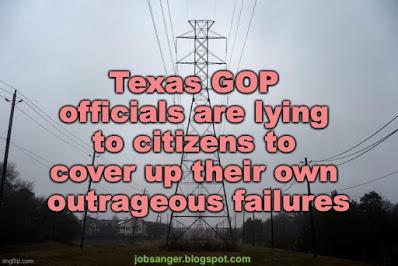 As Texans struggled to keep warm in the midst of the winter weather disaster (and some even died), the Republicans running the state government reacted in their normal way -- THEY LIED!
As Texans struggled to keep warm in the midst of the winter weather disaster (and some even died), the Republicans running the state government reacted in their normal way -- THEY LIED!They tried to blame the power blackouts on the "green new deal" (none of which has been enacted in the state), and renewable energy sources (which power companies neglected to weatherize.
Other states have much worse winter weather, and yet they don't have power blackouts because of it. That's because they have been smart enough to protect their systems from winter harsh conditions. Texas did not! They were warned a decade ago that this could happen, but the legislature just told energy producers that they could winterize if they wanted, but did not require it (so they didn't). In other words, the current disaster in Texas was predicted and preventable, but the Republicans running the state failed in their duty to protect the citizens of the state.
Here is an editorial from the editorial board of The Washington Post on the situation. They have seen through the lies of Texas GOP officials.
TEXAS’S WEATHER and power crisis continued to leave millions shivering across the state Wednesday even as the state’s Republican leaders seemingly lied about the reasons for the disaster. They blamed the blackouts on the state’s supposed overreliance on wind power and warned that transitioning to renewable electricity would spread Texas’s problems across the nation. Nonsense.
The Texas fiasco offers many lessons about keeping the lights on — lessons that Congress and state leaders must act on in the coming months. Not among them is the need to cancel a transition to cleaner sources of energy.
Frozen wind turbines represent only a small fraction of the problem in Texas. The real failure was a lack of preparation. Wind power generally slumps during the Texas winter, so state regulators do not assume they will get much from that power source. Rather, their plans rely heavily on natural gas power plants — and they are the predominant culprits in the current emergency. Across the state, the deep freeze shut down equipment to supply and burn natural gas for electricity, just as demand for electric heating surged and as demand for natural gas for home heating spiked. Freezing also forced one of the state’s nuclear power plants offline. If the state had been more reliant on coal power, as it was a decade ago, frozen coal piles could well have led to similar power plant failures.
Natural gas plants, fuel pipelines, nuclear power stations and, yes, wind turbines can all operate in frigid temperatures. They failed in Texas because they were not hardened to withstand the sort of severe weather that struck the state this week. This was avoidable. The state saw freezing temperatures that challenged the power grid in 2011, after which the need for system upgrades and better planning was obvious. The state did too little over the next decade, and millions of Texans are now paying the price. Blaming renewables is a dishonest way to score political points and divert blame.
Humanity has no choice but to transition to cleaner sources of energy, but the build-out will require smart planning to ensure reliability. That means not only that utilities must deploy methods to store intermittent renewable electricity and that the government must invest in new interstate transmission lines to transfer energy from places where the wind is blowing to others where it is not. It also means building energy infrastructure to resist weather extremes that are likely to be more common. It is certain that heat waves, droughts and wildfires will become more frequent. Scientists are also assessing whether sudden cold snaps like the one that shut down Texas could be related to rapid polar warming, which might be disturbing frigid air currents that generally stay north.
Congress is focused on providing another big covid-19 relief bill. But as federal lawmakers craft their package, they must be sure to leave enough political and fiscal capacity to address in coming months the country’s massive infrastructure needs. That decades-overdue initiative must include an ambitious program to fight and harden the nation against climate change.

